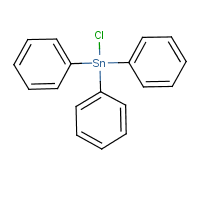Triphenyltin chloride
Agent Name
Triphenyltin chloride
Alternative Name
Fentin chloride
CAS Number
639-58-7
Formula
C18-H15-Cl-Sn
Major Category
Metals

Synonyms
Fentin chloride; Aquatin; Aquatin 20 EC; Brestanol; Chlorotriphenylstannane; Chlorotriphenyltin; GC 8993; General Chemicals 8993; HOE 2872; LS 4442; Phenostat-C; Stannane, chlorotriphenyl-; TPTC; Tinmate; Triphenylchlorostannane; Triphenylchlorotin; [ChemIDplus] UN3146
Category
Tin Compounds, Organic
Description
White solid; [HSDB]
Sources/Uses
Used as rodent repellent, molluscicide, fungicide, miticide, and insecticide; Not currently registered with the EPA for use in the US; [HSDB]
Comments
Hydrolyzed by water to triphenyltin hydroxide; [HSDB] An irritant; Can be absorbed through skin; [MSDSonline] Animals given a single lethal dose have tremor, drowsiness, and ataxia; In other animal studies, has effects on the immune and reproductive systems; [Reference #1] See "ORGANOMETALS." See "Tin, organic compounds."
Reference Link #1
Biomedical References
Exposure Assessment
Skin Designation (ACGIH)
Yes
TLV (ACGIH)
0.1 mg/m3, as Sn
STEL (ACGIH)
0.2 mg/m3, as Sn
PEL (OSHA)
0.1 mg/m3, as Sn
MAK
0.002 mg/m3, inhalable fraction, as Sn
IDLH (NIOSH)
25 mg/m3, as Sn
Vapor Pressure
5.48E-06 mm Hg
Explanatory Notes
The Guide in the Emergency Response Guidebook is for "Organotin compound, solid, n.o.s." Organic tin compounds have a "skin" designation and are classified as "A4" (Not classifiable as human carcinogen); [ACGIH]
Adverse Effects
Neurotoxin
Other CNS neurotoxin
Hepatotoxin
Hepatoxic (a) from occupational exposure (secondary effect) or (b) in animal studies or in humans after ingestion
Reproductive Toxin
Yes
ACGIH Carcinogen
Not Classifiable
Diseases, Processes, and Activities Linked to This Agent
Processes
Industrial Processes with risk of exposure: